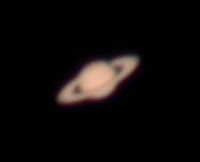20070325 - staying in the solar system
Session name: 20070325.1900
 I arrived at TotL with the Tak 102 refractor just before sunset. A 6 day 20 hour First Quarter Moon hung high over head. I wanted to return my hand to photographing the Moon but I should know bettre if I bring a scope in daylight hours to TotL. As it would happen, I ended up sharing the Solar System with the pedestrians as the stopped by, skipping from Venus to Moon to Saturn. All were enjoying the views during civil and nautical twilight.
I arrived at TotL with the Tak 102 refractor just before sunset. A 6 day 20 hour First Quarter Moon hung high over head. I wanted to return my hand to photographing the Moon but I should know bettre if I bring a scope in daylight hours to TotL. As it would happen, I ended up sharing the Solar System with the pedestrians as the stopped by, skipping from Venus to Moon to Saturn. All were enjoying the views during civil and nautical twilight.At this time Venus was "burning" brightly in the field of view. I wanted to photograph the waning gibbous Venetian disk but decided it was too bright and abandoned any thoughts to try.

 Click on the map to the left to go to the Lunar Atlas Catalog found at LPI.
Click on the map to the left to go to the Lunar Atlas Catalog found at LPI.Contrasting the distances of the objects Charlie & I observed when we attempted a Messier Marathon from Central Park, tonight we stayed local in our solar system. Following Charlie's lead we focuses our attention on a complex crater, Albategnius, and the shadows and light created by the morning Sun on the lunar landscape.
 In this photo I marked up the craters that grabbed our attention. Over the course of the night, even in as little as tens of minutes, we observed the diminishing shadows to the advance of morning sunlight.
In this photo I marked up the craters that grabbed our attention. Over the course of the night, even in as little as tens of minutes, we observed the diminishing shadows to the advance of morning sunlight. Here is a photo of Saturn. Not terribly bad given the setup I have and not tracking mount. As usual, Saturn was shown to the few passersby that came through later in the evening. Andy, Masha, Didier, and his dog (?) stopped to have some looks. I thought that during the clear, steady moments, a lot of detail was visible. Higher magnification did soften the image, but there were moments of great seeing. As in the photo, the shadow of the disk on the rings, the Cassini Division, C ring across the face of the planet, a single, thick, ochre band across the planet, and darkened polar hood. We also saw the four brighter moons with ease: Titan, Tethys, Rhea, and Dione.
Here is a photo of Saturn. Not terribly bad given the setup I have and not tracking mount. As usual, Saturn was shown to the few passersby that came through later in the evening. Andy, Masha, Didier, and his dog (?) stopped to have some looks. I thought that during the clear, steady moments, a lot of detail was visible. Higher magnification did soften the image, but there were moments of great seeing. As in the photo, the shadow of the disk on the rings, the Cassini Division, C ring across the face of the planet, a single, thick, ochre band across the planet, and darkened polar hood. We also saw the four brighter moons with ease: Titan, Tethys, Rhea, and Dione.
<< Home